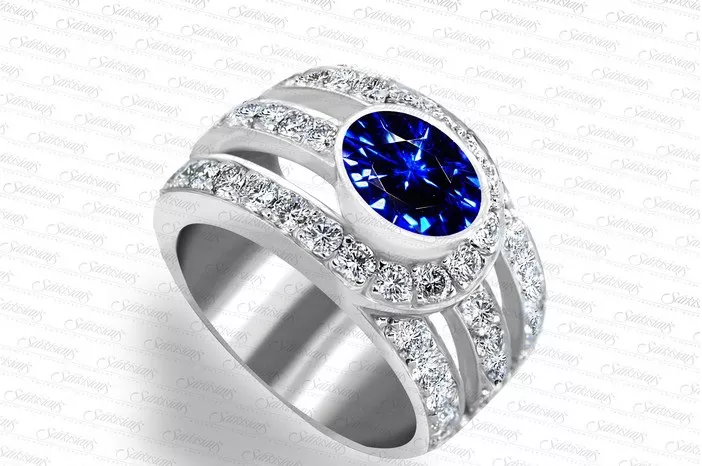Jewelry investment is a fascinating and profitable field that combines aesthetic appreciation with financial growth. Among the myriad of gemstones, yellow sapphire and topaz stand out due to their unique beauty and potential for appreciation. However, understanding which gemstone is more suitable for investment requires a thorough examination of their properties, sources, market demand, and potential for value appreciation. This article aims to provide a detailed and scientific comparison between yellow sapphire and topaz, helping investors make informed decisions.
Properties and Characteristics
Yellow Sapphire
Yellow sapphire, also known as yellow corundum, belongs to the corundum family. It is a transparent gemstone that primarily varies in shades from light yellow to canary yellow, golden yellow, honey yellow, and light brownish yellow. The color of yellow sapphire is generally attributed to the presence of iron oxide. This gemstone is renowned for its hardness, ranking second only to diamonds on the Mohs scale with a hardness of 9.
Yellow sapphires are found in various locations, including Sri Lanka, Australia, Myanmar, Tanzania, and parts of China such as Shandong and Jiangxi. The largest naturally occurring yellow sapphire weighs 46.5 carats and originates from Sri Lanka. It features a golden yellow color, an oval cut, and an internal purity that produces a strong reflection, known as “fire.”
Topaz
Topaz, derived from the Greek word “topazos,” meaning “to search for,” is a silicate mineral composed of aluminum fluoride and hydroxyl. It occurs naturally in a variety of colors, including yellow, but can also be found in blue, pink, orange, red, brown, and colorless varieties. Yellow topaz, in particular, is valued for its hardness (ranging from 8 on the Mohs scale) and transparency, making it a popular gemstone for jewelry.
Topaz deposits are found worldwide, with significant mines in the United States, Brazil, Sri Lanka, Russia, and Pakistan. The gemstone’s hardness and clarity make it resilient to scratching and wear, ensuring its durability in jewelry settings.
Market Demand and Popularity
Yellow Sapphire
Yellow sapphire has gained immense popularity due to its vibrant color and association with positive attributes such as wisdom, prosperity, and good fortune. Its scarcity, especially in the finer grades, contributes to its high market value.
In the gemstone market, yellow sapphire’s demand is driven by collectors, investors, and jewelry enthusiasts. Its unique color and the fact that it is a member of the corundum family (alongside the ruby and blue sapphire) elevate its status and desirability. High-quality yellow sapphires are often compared to diamonds in terms of rarity and investment potential.
Topaz
Topaz, particularly yellow topaz, is known for its affordability and versatility. Its ability to be heat-treated to enhance color and clarity has made it a popular choice for fashion jewelry. Yellow topaz’s bright color and relatively low price point have made it accessible to a broader consumer base.
While yellow topaz may not command the same high prices as yellow sapphire, its steady demand in the mid-range jewelry market ensures its market relevance. Topaz’s availability in various colors and sizes also allows for a wide range of jewelry designs, appealing to a diverse audience.
Investment Potential
Yellow Sapphire
Yellow sapphire’s investment potential lies in its scarcity, especially in natural, high-quality forms. Fine-quality yellow sapphires are rare, and their supply is limited. This scarcity, combined with increasing demand from collectors and investors, drives up prices over time.
The gemstone’s hardness and durability also contribute to its long-term value retention. Yellow sapphires are resistant to wear and maintain their brilliance over extended periods, making them excellent long-term investments.
Investors should note that while synthetic yellow sapphires exist, natural stones hold greater value due to their rarity and authenticity. Identifying natural versus synthetic stones requires professional expertise, which underscores the importance of sourcing gemstones from reputable dealers.
Topaz
Yellow topaz’s investment potential is more moderate compared to yellow sapphire. While it is a beautiful and durable gemstone, its widespread availability and ability to be heat-treated affect its rarity and exclusivity. As a result, yellow topaz typically appreciates in value more gradually and within a more limited range.
That said, yellow topaz still has investment potential, especially for those looking for gemstones with steady, predictable growth. Its popularity in fashion jewelry and affordable pricing make it an attractive option for investors looking to diversify their portfolios with less volatile gemstone investments.
Risks and Considerations
Yellow Sapphire
Investing in yellow sapphire involves several considerations. First, the gemstone’s quality is paramount. Factors such as clarity, color saturation, cut, and carat weight significantly impact its value. Investors should prioritize natural, untreated stones with strong color saturation and minimal inclusions.
Second, sourcing gemstones from reputable dealers is crucial. Authentication and certification by gemological institutions such as the Gemological Institute of America (GIA) can provide peace of mind and ensure the gemstone’s authenticity.
Finally, investors should consider market trends and demand dynamics. Yellow sapphire’s popularity may fluctuate based on consumer preferences and economic conditions. Understanding these factors can help investors time their purchases to maximize returns.
Topaz
Investing in yellow topaz involves fewer risks compared to yellow sapphire due to its lower price point and wider availability. However, investors should still prioritize quality, ensuring the gemstone is free of significant inclusions and has a bright, uniform color.
While yellow topaz’s appreciation may be more gradual, its stability in the mid-range jewelry market offers a degree of predictability. Investors should focus on long-term holding strategies rather than short-term gains, as yellow topaz’s value is more likely to increase steadily over time.
Conclusion
In summary, both yellow sapphire and topaz offer unique investment opportunities within the gemstone market. Yellow sapphire, with its rarity, hardness, and association with positive attributes, holds greater potential for significant appreciation over time. Its limited supply and increasing demand from collectors and investors make it an attractive option for those seeking high-value investments.
Related topic:
- Emerald Cut Purple Sapphire: How to Distinguish Good from Bad
- Emerald Cut Diamonds and Sapphires: How to Match the Most Beautiful Combinations
- Is Aries Suitable for Wearing Yellow Sapphire?


